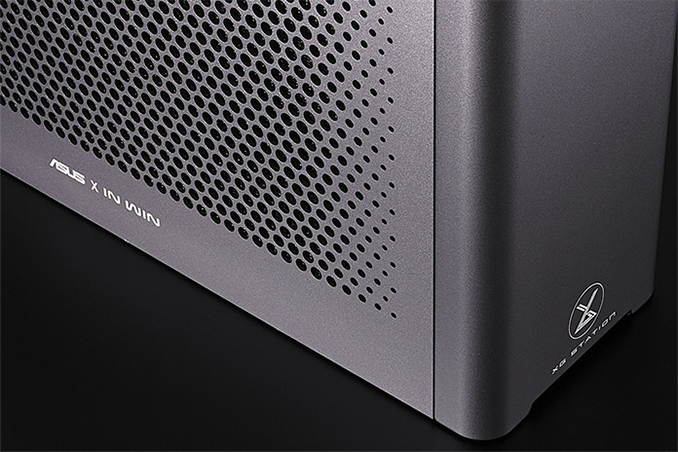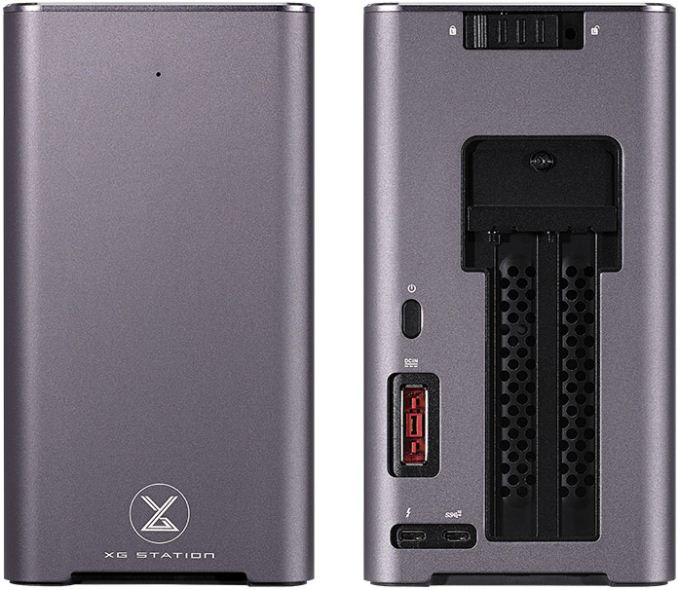ASUS Launches XG Station Pro TB3 eGFX Chassis: 330 W, 2.5-Wide Cards
by Anton Shilov on January 7, 2018 10:15 AM EST- Posted in
- Asus
- Trade Shows
- Thunderbolt 3
- eGFX
- XG Station
- CES 2018
- XG Station Pro

ASUS has announced its latest chassis for Thunderbolt 3 graphics solutions. The new XG Station Pro enclosure was co-designed with In Win and it looks considerably sleeker than the ROG XG Station 2 released in 2017. This new eGFX solution is compatible with the latest high-end video cards from AMD and NVIDIA: the box can accommodate a 2.5-slot wide graphics adapter and comes with a 330 W PSU.
As the names implies, the ASUS XG Station Pro eGFX enclosure was developed with owners of professional-grade laptops (such as the ASUS PRO, ZenBook, MacBook Pro) in mind. For this reason, its design is a far cry from the ROG XG Station 2 eGFX - it is strict, minimalistic, and has a dark grey finish to look the part. While Minimalistic on the outside, the XG Station Pro houses two 120-mm fans and can fit in a 2.5-slot wide video card featuring a tall PCB with two 8-pin PCIe auxiliary power connectors. ASUS says that the fans exhaust warm air out the right side, pulling heat away from the back of the graphics card, which looks like a good organization for airflow. The fans use four-pin power connectors and can be plugged directly into ASUS Strix cards with FanConnect headers to let them react to the GPU temperature. This would enable the fans to remain completely quiet or show their efficiency. Furthermore, two large fans are likely to produce less noise than three high-pressure 60-mm fans of the ROG XGS2 in general. To further appeal to gamers, the ASUS XG Station Pro has integrated lighting that can be customized using the ASUS Aura software to match color schemes and effects with the company's peripherals and ROG graphics cards.
Unlike its ROG-branded brother, the XG Station Pro is not designed an expansion dock for laptops. The XG Station Pro has only one TB3 connector as well as a USB 3.1 Gen 2 header for any extra peripherals like an external storage drive, or a USB hub (for a keyboard, a mouse, etc.). Moreover, unlike the ROG XGS2, the XGS Pro eGFX box uses an external 330 W PSU borrowed from the ASUS ROG GX800 laptop. This power supply is supposed to “feed” both the XGS Pro and its host laptop, so it remains to be seen whether it can do the job under high loads (modern GPUs can consume 250 W of power and more, higher-end 13” machines use ~60 W power bricks, so 330 W is not really a lot). A good thing about the external power supply is that it is potentially upgradeable, but a negative thing about it is that the whole setup gets bulkier and look less elegant with external power supplies (keep in mind that many TB3 docks and monitors also use external PSUs).
ASUS plans to start selling the XG Station Pro already this month for $329, which is considerably cheaper than the current price of the ROG XG Station 2 ($549). The latter product is not going anywhere, but the new one will be a considerably more cost effective TB3 eGFX option from ASUS.
Last year ASUS released its ROG XG Station 2 eGFX TB3 enclosure targeting gamers that require maximum performance and expandability. The ROG XG Station 2 integrated a 600 W PSU, had a Gigabit Ethernet header, and four USB 3.0 ports. The USB ports do not use TB3 bandwidth because they rely on their own USB 3.0 Type-B interface, so the whole ROG XGS2 needs three cables to operate, which is good enough for gamers, but may not be comfortable for all users. Since the ROG XGS2 was developed by the Republic of Gamers team, its chassis is covered by Mayan patterns and aim to loosely (but not really) match the design of non-gaming laptops. By contrast, the new eGFX chassis from ASUS is an entirely different product.
Related Reading
- ASUS ROG XG Station 2 eGFX Enclosure with Thunderbolt 3 Launched
- ZOTAC Unveils AMP Box and AMP Box Mini eGFX TB3 Chassis
- PowerColor Announces Gaming Station: The Devil Box’s Spawn, TB3 eGFX Enclosure
- GALAX, KFA2 Launch SNPR External GPU Enclosure with GTX 1060 6 GB
- Razer Launches Core v2 TB3 eGFX Enclosure: Dual TB3 Controllers
- Gigabyte Releases AORUS GTX 1080 Gaming Box: Upgraded GPU, Same Size Chassis
- Aorus Announces the GTX 1070 Gaming Box eGFX Adapter
- AKiTiO Introduces Node: Thunderbolt 3 eGFX Box for $299
- PowerColor Announces Devil Box: Thunderbolt 3 eGFX Enclosure
Source: ASUS













3 Comments
View All Comments
DanNeely - Sunday, January 7, 2018 - link
" A good thing about the external power supply is that it is potentially upgradeable, but a negative thing about it is that the whole setup gets bulkier and look less elegant with external power supplies (keep in mind that many TB3 docks and monitors also use external PSUs)."I tend to disagree, especially about the bulkier remark. As long as the internal PSU is a standard desktop design it massively adds to the bulk of the enclosure. If it's behind the GPU it makes the whole thing 2-3" wider with the ~2/3rds to 3/4ths of the volume forward of the PSU being dead space. Below and upright adds about 5" to the height again mostly deadspace. Below and horizontal adds 2-3 to height and 1-2 to width.
Putting it in front of the card would eliminate the large amount of excess volume added; but means either only supporting shorter cards or a really long enclosure that could become troublesome to arrange on a desk.
A custom designed PSU for the enclosure, long, short, skinny and cooled by several low profile 80 mm fans that only added an inch and a half or two to the height while going a good portion off the front/back length would make the best of cramming a PSU in without bulking the box up excessively; but AFAIK no one has done so yet.
nerd1 - Monday, January 8, 2018 - link
One can easily cram a full gaming PC inside that big case... which renders the whole idea of eGPU moot.Death666Angel - Monday, January 8, 2018 - link
I'd rather have one thing that is slightly larger (SFX PSU integrated into the case) than 2 things that are large and add another cable to the setup. A quick search shows a 330W Dell adapter as being 19.5 x 9.5 x 4 (~740) cm³ big. A 450W Corsair SFX PSU is 12.5 x 6.4 x 10 (~800) cm³. Flex-ATX can go even smaller (300W Seasonic is 8.2 x 4.1 x 15 (~480) cm³). So integrated is almost always less bulky than external. And sure, a specially designed custom PSU would reduce bulk even further. But I'd rather have something I can replace easily with off the shelf components than lose another couple cm and have a louder system.